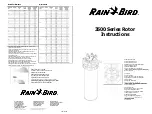
DOC. MIE91093 Rev. 1.34
Page 65 of 145
This means that V2 turns slightly quicker than V1, so V1 sees
V2 turning at a frequency of
F = 50.1-50 = 0.1Hz: 1 turn
every 10”. This means an angle variation of 360° / 10s =
36°/s.
If we have a relay where:
. Angle sector = ± 5°;
. Operating time: 0.1s,
the maximum frequency differential that allows the relay to
trip can be computed as follows.
. Total operating angle sector: 5+5=10°;
. Maximum angle ROC: 10°/0.1s = 100 °/s;
. Maximum frequency differential. Since 360°/s correspond to
1Hz, 100°/s
≡
100°/360° = 0.278 Hz.
So, these parameters are related to each other.
This discussion leads also to the mode of performing the test:
. The voltages should be shifted by the maximum allowed
angle plus something, so that we start from the not
synchronized condition (in our instance, - 6° or + 6°);
. Start the test with the programmed frequency differential:
negative differential starting from the negative angle limit;
. The frequency limit is found by a series of tests with different
frequencies around the specified limit;
. The test will have a maximum time equal to a multiple of the
operating time (for instance, 2 times). However, for some
relay the enable is given only after a complete tour in the
enabled situation; in this instance, test time is computed as
follows:
(test time) = 1.1 * 1 /(FNOM – FTEST)
The fact that we have to start the test from the not
synchronized condition is critical, because:
. When we are OFF, voltage V1 is not applied;
. If we start the test by applying V1 that has a given phase
shift and frequency differential with respect to V2, the relay
could behave the wrong way. To avoid this, we take advantage
of the pre-fault duration selection, during which V1 and V2 at
nominal frequency, but with the programmed phase shift, for
















































